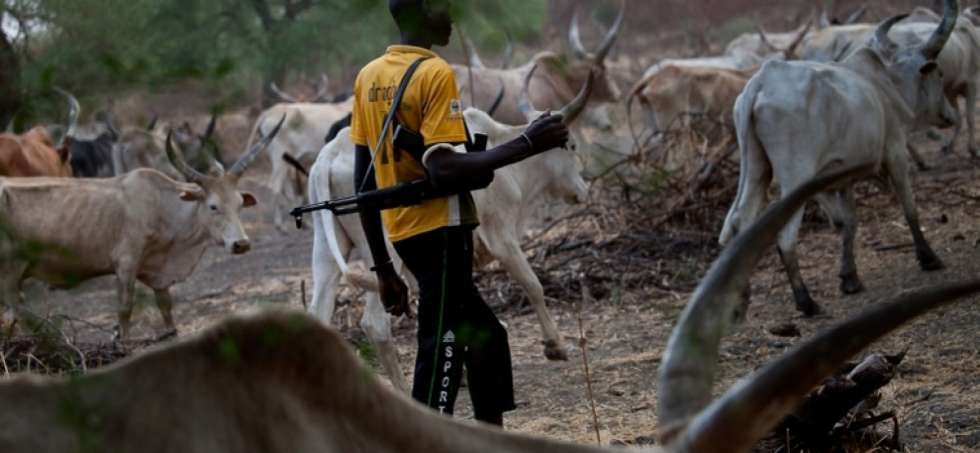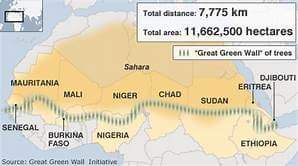The ongoing rise in herdsmen/farmers clashes in parts of the country has forced experts to conduct researches with a view to find out government programmes that would have solved the crisis ahead of time, but was not implemented to the letter.
One of the key schemes that got approval in 2014 to green the desert region of the country in line with African Union agreement is the Great Green Wall scheme.
Business Hilights gathered that 2014, federal government earmarked about N10bn and handed same to the National Agency for the Great Green Wall Project (NAGGW) to drive conversation and fight desertification and the herdsmen challenge.
Mr Goni Ahmed is Director General and reports to the Minister of Environment.

Followers of the Fulani herdsmen ‘insurgency’ have raised concerns over how the federal government was silent on the progress made by NAGGW, if any, rather than thinking of another form of colonization in the name of Cattle Colony which had been rejected by several states.
Checks in parts of the north showed that not much was done by the agency upon all the yearly allocation via the Ministry of The Environment.
The Great Green Wall initiative is a pan-African proposal to “green” the continent from west to east in order to battle desertification. It aims at tackling poverty and the degradation of soils in the Sahel-Saharan region, focusing on a strip of land of 15 km (9 mi) wide and 7,100 km (4,400 mi) long from Dakar to Djibouti.

The Global Environment Facility notes, “Populations in Sahelian Africa are among the poorest and most vulnerable to climatic variability and land degradation. They depend heavily on healthy ecosystems for rainfed agriculture, fisheries, and livestock management to sustain their livelihoods. Unfortunately, increasing population pressures on food, fodder, and fuelwood in a vulnerable environment have deteriorating impacts on natural resources, notably vegetation cover. Climate variability along with frequent droughts and poorly managed land and water resources have caused rivers and lakes to dry up and contribute to increased soil erosion.”
There is a tidy sum of about US$81m involved in this project. One writer, Dylan Thuras, notes that more money is available. He states, “.. International organizations have pledged over $3 billion toward the completion of this massive environmental project, designed to help stop land degradation.”
The African Union backs it. “In June 2010, Burkina Faso, Chad, Djibouti, Eritrea, Ethiopia, Mali, Mauritania, Niger, Nigeria, Senegal and Sudan signed a convention in Ndjamena, Chad, to create the Great Green Wall (GGW) Agency and nominate a secretary to develop the initiative further.”
Member countries choose their priorities and get funding from the Global Environment Facility. That body reports that Niger has made the most progress. “Progress is apparent especially in the Zinder region of Niger, where tree density has significantly improved since the mid-1980s. GEF CEO Monique Barbut attributes the success to working with farmers to find technical solutions, particularly long-term land and financial solutions, in order to save the trees.”
Nigeria commenced implementation in 2013 and in 2014 set up the Interim Office of the National Agency for the Great Green Wall with the appointment of an Acting Director General. Nigeria’s GGW programme involves 11 states. Benefitting states are Adamawa, Bauchi, Borno, Gombe, Jigawa, Kano, Katsina, Kebbi, Sokoto, Yobe and Zamfara. It involves the establishment of a greenbelt covering 1500km from Dandi Arewa Local Government Area of Kebbi State to Marte in Borno State.
The National Agency for the Great Green Wall says “The mission of the NAGGW is to halt and reverse land degradation, prevent depletion of biological diversity, ensure that by 2025, ecosystems are resilient to climate change and continue to provide essential services that would contribute to human welfare and poverty eradication.”
However, agro experts have come up with another idea of converting recovered Sambisa Forest in Borno State to a national cattle ranch as it has capacity to contain well over 18m cattle at once.

Wikipedia states that the forest occupies parts of the states of Borno, Yobe, Gombe, Bauchi along the corridor Darazo, Jigawa, and some parts of Kano state farther north. It is administered by the Local government areas of Askira/Uba in the south, by Damboa in the southwest, and by Konduga and Jere in the west”
Before the emergence of Boko Haram, Sambisa had hosted a Game Reserve in the past covering from 686sq km to 2258sqkm.
Wikipedia states that the forest occupies parts of the states of Borno, Yobe, Gombe, Bauchi along the corridor Darazo, Jigawa, and some parts of Kano state farther north. It is administered by the Local government areas of Askira/Uba in the south, by Damboa in the southwest, and by Konduga and Jere in the west”
Wikipedia adds: “BirdLife International reported that 62 species of birds have been recorded in the Sambisa Game Reserve,[6] including the guinea fowl, francolin, village weaver, Abyssinian ground hornbill, Arabian bustard, Savile’s bustard, African collared-dove, Chestnut-bellied starling, black scrub-robin and the Sudan golden sparrow. The forest was also thought to be the last remaining site of the ostrich in Nigeria.
17 species of mammals were reported in 2010 in the Sambisa Game Reserve[4] including, baboon, patas monkey, tantalus monkey, Grimm’s duiker, red-fronted gazelle, African bush elephant, roan antelope, hartebeest, African leopard and spotted hyenas”.
Only recently, federal government has decided to establish cattle colonies in every state of the country. Each colony will be five thousand hectares of land (5,000). This will be for Fulani herdsmen.
Basic statistics are important to note; 1hectare is a football field; 10 hectares is one square kilometer; 100 hectares is 10 square kilometers; and 1,000 hectares is 100 square kilometers, ie 100,000m by 100,000m.
The last fact but not the least is that 5,000 hectares is 500 square kilometers, ie 500,000 m by 500,000m. This is a stretch of 25 kilometers by 20 kilometers of land mass. This is the kind of land mass government is proposing for the Fulani colonies.
This for example is an expanse of land stretching from Zuba to Gwagwalada to Airport junction to kuje to Aya towards Nyanya to Buari and environs.
As it is, many local Governments land mass in Nigeria are smaller than one colony?. In fact almost every local government in the South south, south East, and South west is smaller than one colony.
Whereas some pundits see the plot as another strategic way of establishing one Fulani local Govt Area in every state of Nigeria, studies show that there is only one cattle colony in the whole world? It is in Pakistan, near the town of Karachi.
Another line of reasoning shows that just as Nigerian Landmass is 923,768sq.km, the proposed Cattle Colony is planned to occupy 10,000hectares per State and FCT which means about 37 locations.
If Cattle Colony occupies about 370,000hectares of Nigerian landmass, technically Fulani Herdsmen will become owners of about one-third of Nigeria.









